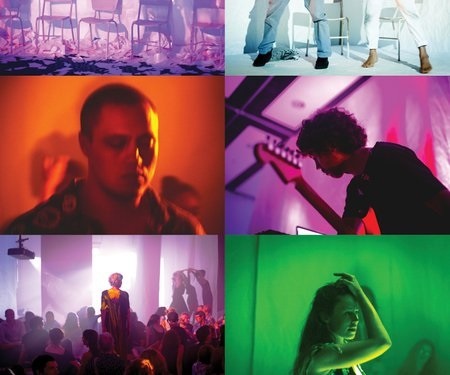There’s a certain magic about a transformed space. A magic that has successfully been created by the artists of Movement of The Human, with their theatrical experience Rushes.
As I walk into the Lower NZI in Aotea Centre, I am transported out of the ordinary and into what is distinctly a performance-ready space. Large sheets of white paper construct the walls of a makeshift bar area which doubles as an anticipatory holding pen for the audience.
As the audience mingles, haze and purple lights add to an atmosphere created by music playing just above conversation level. This immediate immersion into Rushes indicates we already may be experiencing a performance. Eden Mullholland encourages this feeling as he appears in an entrance to the white-walled space, microphone in hand, singing. Mullholland turns and moves into the room behind him exposing a space dotted with multiple dancers. The audience follows and enters the room. Eyes closed, dancers fill the space, attempting to maintain their balance as they stand with their heels lifted. The dancers endeavour to remain still, aided by outstretched arms. The forest of bodies obstructs the audience from moving towards the doorway at the opposite end of the room. Between the dancers there’s just enough space to invite the audience to navigate through the bodies, forcing an immediate intimacy between audience and performers.
This room is the first of many. The white paper walls construct distinct rooms, corridors, and paths which manage to both direct and deceive the audience. Each of these spaces offers a different performance moment, relationship or context.
Some audience members promptly move through the first room to the next, others linger. This begins the disintegration of the audience as one group, and individuals start to coordinate their own Rushes experience.
I move into a second room where black cloth creates a box containing two dancers elevated on a pedestal. Projected light creates patterns on the black fabric and the bodies inside are blurred and faces obscured. The dancers move in intimate proximity to each other, wrapping around one another. In contrast to the previous room where I felt invited to be close to the balancing dancers, here I feel oddly intrusive, gazing at the two dancers as they embrace. As I watch the performers, my moment of intrigue is pleasantly disrupted by a conversation of two other audience members as they discuss the source of light. This unique performance space allows for such interactions because the audience can be relaxed through creating their own experience. Sitting, standing, watching, participating or talking, as an audience we are not dictated by an assumed appropriate etiquette, rather encouraged to immerse ourselves within Rushes however we feel.
I continue moving through the many rooms, and some particular highlights include discovering hidden areas glimpsed in a restricted way through small gaps in the white walls. The diverse performance moments of Rushes toy with my comfort and voyeurism as an audience member. Whether peering through a peephole to a forlorn looking woman or interrupting a solo dance moment by swinging balloons into the mover, I am able to experiment with my own engagement with the work.
As the audience travels the space, the performers also swiftly navigate their way from room to room, performance to performance. This creates a particularly intriguing aspect of Rushes, as I am now aware that I am constantly missing out on something. The multiple simultaneous performance moments mean that as an audience member I am momentarily excluded from various dance, acting, lighting or live music performances. Upon returning to any room I find new performers or an additional immersive element.
With more than 25 dancers and the many audience members, each performance interaction is a unique experience for all present. After a satisfying journey through this space the self-directed element of the performance is disrupted by the dancers. The audience swarms towards the largest of the rooms where a final dance moment brings all performers together. A particularly pleasant ingredient of Rushes is highlighted in these final moments of the experience, the diverse performance cohort. Regardless of age, reputation, or discipline, each performer holds a significant role in the magic that is Rushes.
My experience of Rushes is unique, and this will continue as I am certain there will be further surprises each performance night this week. This show manages to be both welcoming for those who may be intimidated by a typical theatre setting, whilst also being engaging for those more confident to experiment with audience participation.
Movement of The Human and contributing artists have transformed multiple art disciplines into an immersive experience that is a must-see(do) during this Auckland Fringe Festival!
Copyright © in the review belongs to the reviewer





Comments